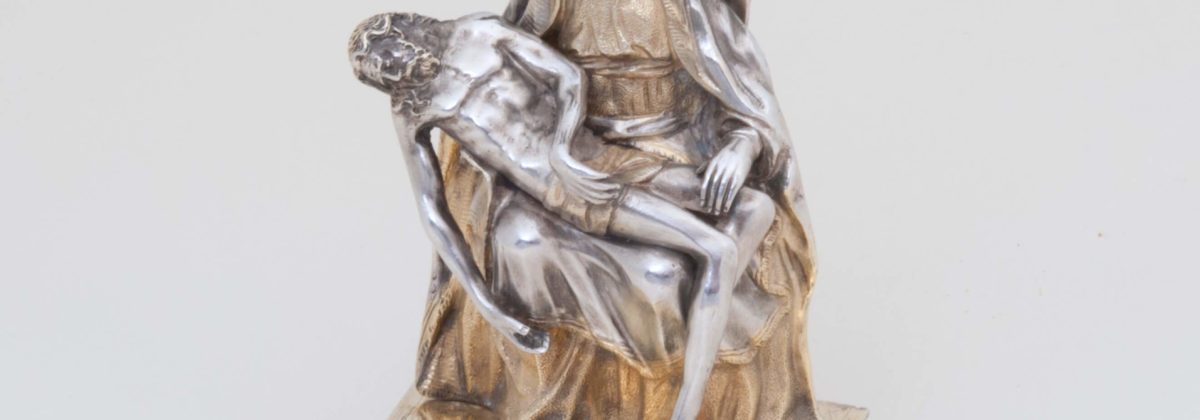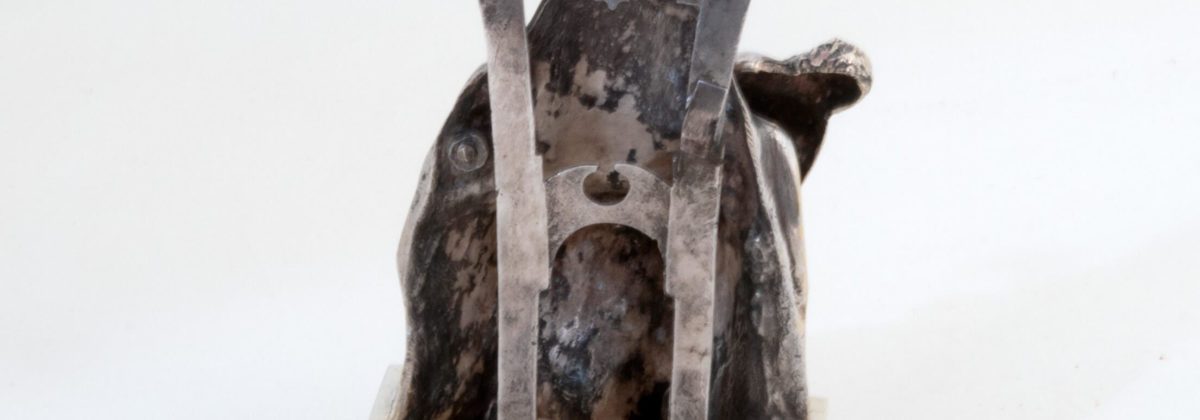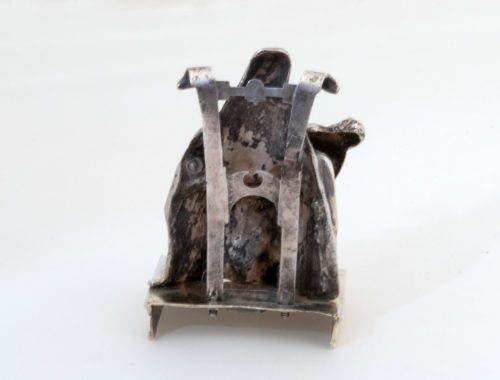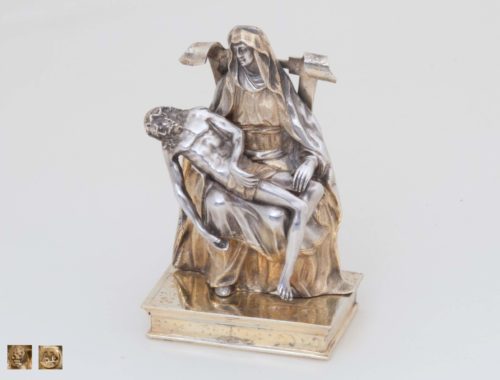Detailed Information
German Sculptural Lamentation, Silver, Gilt
This present, silver, partly gilt, small-format sculpture, is a group of two figures depicting the Virgin Mary and Christ. Mary is shown in an upright, seated position; on her knees she holds the body of Jesus taken from the cross. Mary’s head is turned towards Christ and her left hand lies on his left thigh. She is depicted frontally and occupies the vertical axis of the group. The rotation of her head, however, allows a view from several sides. The rotation is highlighted by the forward placed knee in comparison to the other. She is dressed in an overhanging garment with rich folds and fine details, leaving her face, neck and hands uncovered and decorated with rich punch work. The figure is immersed in itself.
The parallel axis of the composition comprises of the Corpus Christi occupying diagonal position. The upper body of the dead has a lateral position with the head inclined downwards, resting in crook of Mary’s arm. Whilst a Gothic reminiscence hangs of the right arm. Christ has long hair, a beard and is covered with a small loincloth while his body and face is particularly reminiscent of the crucifix type Christus created by Giambologna. The position of Christ breaks the frontality and adds a liveliness to the composition, allowing the observer to experience the compassion and mercy within this piece.
The two figures are mounted on a pedestal decorated with fine engraving, accompanied by the appropriate marks. Behind Maria, a structure is positioned in order to support the composition. The figures are screwed together (which is visible from behind). The marks are on the pedestal as well as the supporting structure.
This depiction of the lamentation scene is based on sculptures with the same theme from Southern Germany. The pedestal, the unworked back, but also the small dimension of the sculptural group indicate that this was made for personal use and above all for individual prayer at a home altar. The maker Abraham II Lotter manages to combine intimacy, devotion, humanity, compassion and spirituality in a small sculptural ensemble.
The Lamentation (Pietà)
The theme of the Lamentation belongs to the so-called devotional pictures, which have appeared in German sculpture since about 1300. The term Lamentation is used to denote the last farewell of the Mother of God between the moment of deposition of the cross and the burial of Christ. When the individual phases of the Passion are distributed according to the times of the day, the events mentioned above fall into the “vespers” (in the late afternoon) of Good Friday, hence the name. The lamentation presents a closed group of two figures: Virgin Mary holding the body of Christ on her lap. The Gospels do not report on the scene; it is assumed that the iconography’s origins go back to lyrical creations and mystical literature or even that it springs up from Byzantine iconography. The lamentation therefore had no liturgical function during the Middle Ages but served for the intimate use of the praying person. The pictures of the Man of Sorrows and the Christ-Johannes-Group are also regarded as devotional pictures. In Italian this artistic theme is called Pietà (Mercy) and is commonly used in English, French, Vierge de Pitié and in German, Vesperbild.
Already in the 14th and 15th centuries, the Lamentation as a sculptural group played a central role in German art. The Middle Ages and the historical conditions at that time contributed significantly to the development of this devotional motif. In the 17th century, in the course of Catholic renewal and deep religiousness, this motif was taken up again. It became an important part of the representation of Mary and was a common theme in Northern Europe, yet still less common than the image of Madonna with the Child Jesus. An image which, in Southern Germany, artists have intensively worked on. Artistic representation of pain, suffering and death, but also ideal body shape and hope of salvation are inseparably connected with the Lamentation.
Baroque art and culture should be seen in the context of the Council of Trento (1545-63). Within the Tridentine Council, developed and recorded principles for the worship and representation of religious images can be noted. Along with this, artists were expected to provide inspiration for the faithful to pray intensely.
The Lamentation in the Oeuvre of Abraham II Lotter
In the field of silver artworks, during the opening of the 17th century, an abundance of full plastic silver figures, created for churches and cathedral, can be observed. This flowering of silver sculpture in a large format can also be seen reflected in smaller silver works. In addition to this, home altars by Augsburg craftsmen took on a distinct characteristic in the same period. The home altar of Albrecht V (Treasury of the Residenz, Munich; masters: Abraham I Lotter and David Altenstetter, c. 1573-4) serves as a reference work for this category of works. Like private altars, silver nativity scenes belong to the same category of silver of ecclesiastical or religious content.
Abraham II Lotter, the maker of the Lamentation group examined here, was very familiar with the genre of the altar and the silver nativity scenes. Two known works by him showcasing his talent and skill for sculptural figures and architectural pieces of art made in silver can be seen in Seling, figs. 52 and 53.
An almost dentical representation of Pieta by Lotter can be found in the upper level (aedicule) of the richly decorated and architectural home altar of Maria Loreto in Prague. The Prague home altar was donated by Countess Benigna Catharina of Lobkowitz in 1626 and the silver works were made by Abraham II Lotter. Moreover, a silver nativity scene of Abraham II Lotter belonged in the collections of the Bavarian National Museum but was stolen at the World Exhibition in Montreal in 1967. The figurative execution of it as well corresponds to that of the home altar of Loreta in Prague.
The present Lamentation sculptural group and the stolen silver nativity scene correspond thus both to the representations of the same respective themes used in the Loreta home altar.
Finally, one can see the influence of corresponding sculptures of Christ by the sculptor Giambologna (1529-1608) on the overall design of the body of Christ. Abraham Lotter certainly knew the figure of Christ on the Crucifix of Giambologna in the Church of St. Michael (Jesuit Church) in Munich (1594). In 1605-7, the German pupil of Giambologna, Hans Reichle (around 1570-1642) created the Crucifixion group, specifically the figure of Jesus Christ, in the Catholic parish church St. Ulrich and Afra in Augsburg in the style of Giambologna. The figure of Christ in this present Pieta is very similar to both these figures.
Maker
Abraham II Lotter, goldsmith, son of Matthew (Protestant), born around 1580, became a master around 1613 (1614: entry into the guild), married in the same year, and died in 1626. Well-known works of Abraham II Lotter include: a silver Nativity Scene, around 1620 (Seling, Fig. 52, formerly Bavarian National Museum) and a home altar (gilded, ebony) with Nativity Scene, Pieta and Salvator Mundi around 1625 in the Maria Loreto at Hradèany, Prague (Seling, Fig. 53).
Literature
Finke, Jutta, Das Vesperbild in der Süddeutschen Plastik des 17. und 18. Jahrhunderts, Diss. LMU München, 1985.
Müller, Th. ‚Ein Augsburger Silberaltärchen in Prag‘, in: Hernmarck, C., Nordenfalk, C., Nationalmuseum, Stockholm (Hrsg.), Opuscula in honorem C. Hernmarck, Stockholm: Nationalmuseum Stockholm, 1966, p. 159-66.
Zech, H., ‘When Christ became an astronomer: the contrasting history of two seventeenth-century Augsburg shrines’, in: Silver Society of Canada Journal, 2015, vol. 18, p. 12-30.
Avery, Ch., Radcliffe, Ant., Leithe-Jasper, M., Arts Council of Great Britain, Kunsthistorisches Museum Wien, Österreichisches Kulturzentrum (Hrsg.), Giambologna: Ein Wendepunkt der europäischen Plastik, Ausst. Kat., Wien: Kunsthistorisches Museum, 1978.
Jesuitenkirche St. Michael München, Regensburg: Verlag Schnell & Steiner/Kunstführer Nr. 130, 2016.





